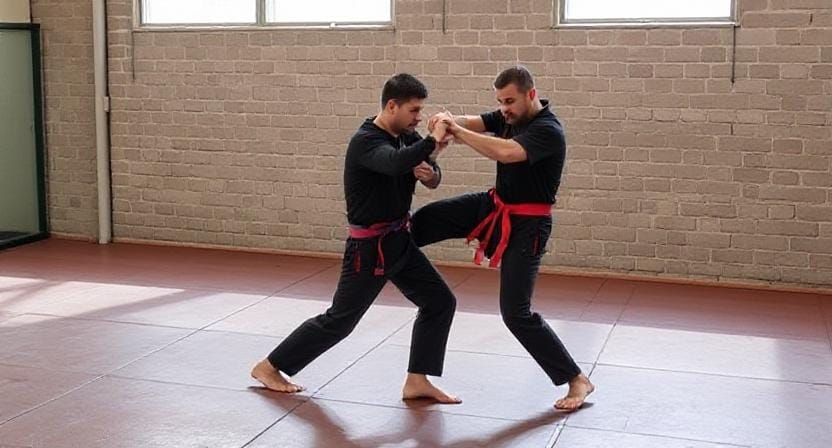Please Note: This post may contain affiliate links. If you click one of them, we may receive a commission at no extra cost to you. As an Amazon Associate, I earn from qualifying purchases.
Last Updated on November 2, 2025 by Kevin Collier

Top Takeaways and Key Concepts
– Learn basic self-defense moves to protect yourself in various situations.
– Practice situational awareness to identify potential threats early.
– Train regularly to improve your physical fitness and reflexes.
– Understand how to use leverage and position against an opponent.
– Keep legal self-defense tools accessible and know the regulations.
Let’s be real. When we think of preppers, it’s easy to picture someone in camo, crouched in a basement full of beans. But, prepping isn’t just about canned goods. It’s about being ready for anything life throws at you.
Self-defense? Super important. Imagine you’re walking home, and something feels off. You want to be prepared, right? So, let’s chat about some basic self-defense moves that everyone should know, even if you’re just going to the store.
First things first, trust your gut. If something feels wrong, listen to that feeling. It’s like a little alarm going off. Pay attention!
Now, if you ever find yourself in a tricky situation, know how to create space. You don’t have to be a black belt. Simple moves can make a big difference. If someone gets too close, a firm push can help. Use your voice, too. Yelling “Stop!” or “Back off!” can draw attention. Like a superhero call for help!
Learning some basic techniques is easy and super empowering. You can join a class or watch videos. Practicing with friends is fun! Laughing while you learn makes things less scary. Plus, those laughs turn into good memories.
Let’s talk about keeping your wits about you. Being aware of your surroundings can be your best friend. If you see something strange, make a mental note. It’s like playing detective. Knowing where the exits are can help, too. You want a plan, just like a movie hero.
Packing a little pepper spray or a personal alarm can be a smart backup. It’s like carrying a mini safety net. You won’t use it every day, but knowing you have it can make you feel more secure.
So, grab a snack—maybe something crunchy—and think about this. Prepping isn't just about food; it’s about being ready for whatever comes your way. Everyone can learn self-defense. You’ll feel braver and more confident. And hey, you might even inspire someone else to join you on this journey!
*** Shop for Survival Gear - Tools - Kits ***
Survival Gear - Bags and Backpacks - Knives - Boots/Footwear - Communication
Outdoor Cooking - Gloves - Hydration - Dry Boxes - Water Filtration Systems
Tents - Sleeping Bags - First Aid Kits - Multi-Tools - Flashlights - Fire Starters
Navigation - Survival Food - Night Vision - Headlamps - Stun Guns - Binoculars
The Importance of Situational Awareness

Having situational awareness is like having superpowers, but you don't need to wear a spandex costume. It involves being aware of what's going on around you and spotting possible risks before they turn into serious difficulties. You know, like when you notice that shady guy in a trench coat who looks too interested in your garden gnome collection.
Practice scanning your surroundings often to improve your situational awareness. Are there people hiding around? Is anyone acting weird? I once saw someone looking at my treasured tomatoes with what can only be called “malicious intent.” You really want to catch these things early!
This doesn't imply you should be paranoid all the time; just keep an open mind. Stay attentive but calm; you don't want to look like a deer caught in headlights or, even worse, like someone who just found out they were out of coffee.
Basic Techniques for Striking

So you know what's going on around you, but what if things go wrong? This is when basic hitting skills come in. You don't have to be Bruce Lee; just knowing a little bit will help a lot! Think about how many times you've stubbed your toe on furniture. Now picture utilizing that same energy to fight off an attacker.
Begin with easy punches and kicks. A well-placed jab can stop unwanted attention faster than I can say “not today!” You can practice these movements at home, but be careful not to let any family members get too close, or they might be kicked in the face while you're eating.
And speaking of kicks, don't forget how powerful a knee strike can be! If someone approaches too near for comfort, driving your knee into their stomach can offer you enough room to move away or at least give them something to think about as they recover from the shock.
How to Grapple

Let's talk about grappling methods now, because sometimes fights get really close (and not in a fun way). If you know how to grapple, you can control your opponent without having to use raw force. To be honest, it's like playing Twister but with more at stake.
Learn how to do simple grips like headlocks and wrist grabs. These maneuvers let you change someone's body posture without having to be bigger or stronger than them. This is wonderful news if you're more of a “petite flower” than a “muscle-bound superhero.”
If you practice these skills often (with a willing partner if possible), you'll feel more at ease when you have to deal with an unexpected conflict, as when that neighbor attempts to borrow another cup of sugar but becomes too touchy this time!
Ways to Get Away

Let's be honest: sometimes the best thing to do is go away! Knowing how to get away swiftly and easily can help you avoid perilous situations. It's more important to get out safely than to show how tough you are.
One common way to get out of wrist grabs is to twist toward the attacker's thumb, which is the weakest area of their grip. Trust me, this works better than attempting to get away like you're stuck in quicksand!
Also, throughout an encounter, practice moving toward exits instead of standing motionless. This may seem easy, but it's easy to forget when you're stressed. When you're in danger, remember that haste is important! Like running to dessert after dinner—get out of there fast!
Using Common Things As Weapons Of Defense

You might be amazed at how many things you use every day can also be used to protect yourself. Does anyone honestly think Grandma's knitting needles could be used for something else? In fact, virtually anything that is sitting around could help.
Keys are typical makeshift weapons. Holding them between your fingers gives you extra protection when you're near to someone, and believe me, no one wants those keys poking at them! Umbrellas aren't only for rain; they can also be used as shields or even weapons if you need to (but don't try to open them inside).
And don't forget about our trusty pepper spray! Remember that aiming for eyes isn't as straightforward as aiming for targets at archery practice. You can miss and accidently spray yourself instead. which would not improve things at all!
Being Mentally Ready For Battle
Lastly, and maybe most crucially, being mentally ready is very critical in self-defense scenarios. Learning physical skills is one thing; staying calm under pressure is a whole other thing. After all, stressing will only make you make bad choices, as shown by my hurried quest for munchies on movie night!
Do visualization exercises where you picture yourself calmly and confidently reacting to different situations based on what you've learned in this article (or any other resources you have). Keep in mind that confidence leads to effectiveness!
Being ready is more than just having your favorite gear or a stash of snacks. It's a lot more. No joke. It's about being ready and safe in both your body and mind.
Take a moment to think. You could have all the supplies you need, but if you don't feel sure of yourself, things can get hard. It's really important to know how to keep yourself safe. It provides you a tiny boost, like wearing your lucky socks. Do you remember what we talked about when it came to self-defense? They're not just steps. They help you keep calm when things are tough.
Getting ready mentally is just as important. Have you ever heard of being mindful? Like taking a deep breath when you're feeling stressed. It's about keeping your mind on what you need to do, even when circumstances get wild. You can do this at any moment, even when you're drinking coffee. It's all about being present.
Making a strategy for crises is one method to deal with things. It doesn't have to be hard. It doesn't take much to make a significant difference. Make a list of what you would do in different situations. You'll feel like a superhero, ready for anything!
Also, stay interested. Get better at things and keep your mind sharp. You feel more ready the more you know. Taking a self-defense lesson or just reading a new book. Everything matters.
So, get a cookie or anything else tasty. Being ready is all about finding the right balance. It's not just about things; it's about everything about you.
Frequently Asked Questions
Why should preppers learn self-defense techniques?
Self-defense skills help protect you from physical threats and improve overall preparedness.
How important is situational awareness in self-defense?
Situational awareness allows you to detect risks earlier and avoid confrontation before it starts.
Do you need martial arts experience to defend yourself?
No, simple techniques such as strikes, pushing, and creating distance can be effective without advanced training.
What is leverage in self-defense?
Leverage uses angles and body positioning to overcome strength, allowing a smaller person to control or escape from an attacker.
Why practice self-defense techniques regularly?
Training improves reflexes, confidence, and immediate reactions during stressful moments.
Can everyday items be used for defense?
Yes, common objects like keys, umbrellas, and personal alarms can be improvised defensive tools.
Are legal self-defense tools allowed everywhere?
No, laws vary by region, so learning your local regulations before carrying defensive gear is necessary.
Suggested Resources:
Self-Defense Tips
https://www.selfdefense.com/tips/
Beginner's Guide to Self-Defense
https://www.beginnersselfdefense.com/guide/
Situational Awareness Training
https://www.situationalawareness.org/training/

Kevin Collier is a seasoned survivalist and expert in prepping and homesteading, contributing to WiseSurvive.com. With a deep-rooted passion for self-sufficiency and outdoor survival skills, Kevin shares practical advice, strategies, and resources to help individuals prepare for any challenge. His informative articles cover a range of topics, from essential survival techniques to sustainable living practices, empowering readers to thrive in any situation. Whether you're a novice or a seasoned prepper, Kevin's insights will inspire you to take charge of your readiness and build resilience for the future.




